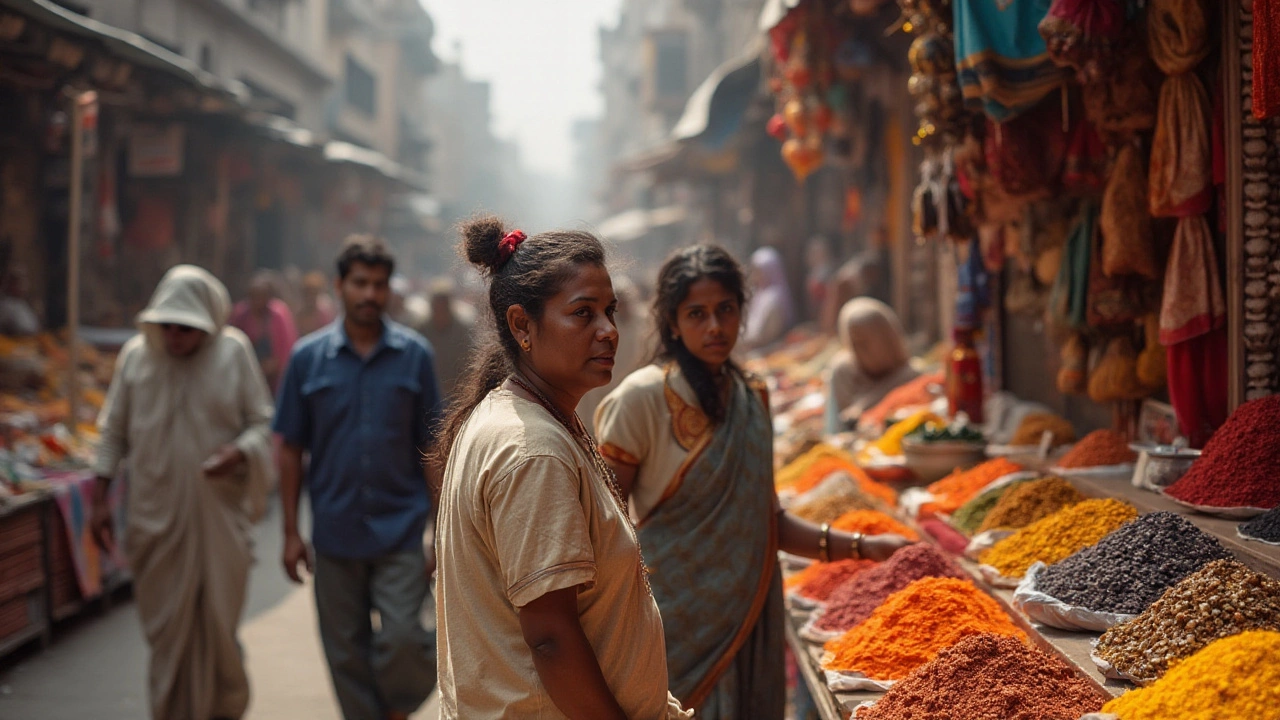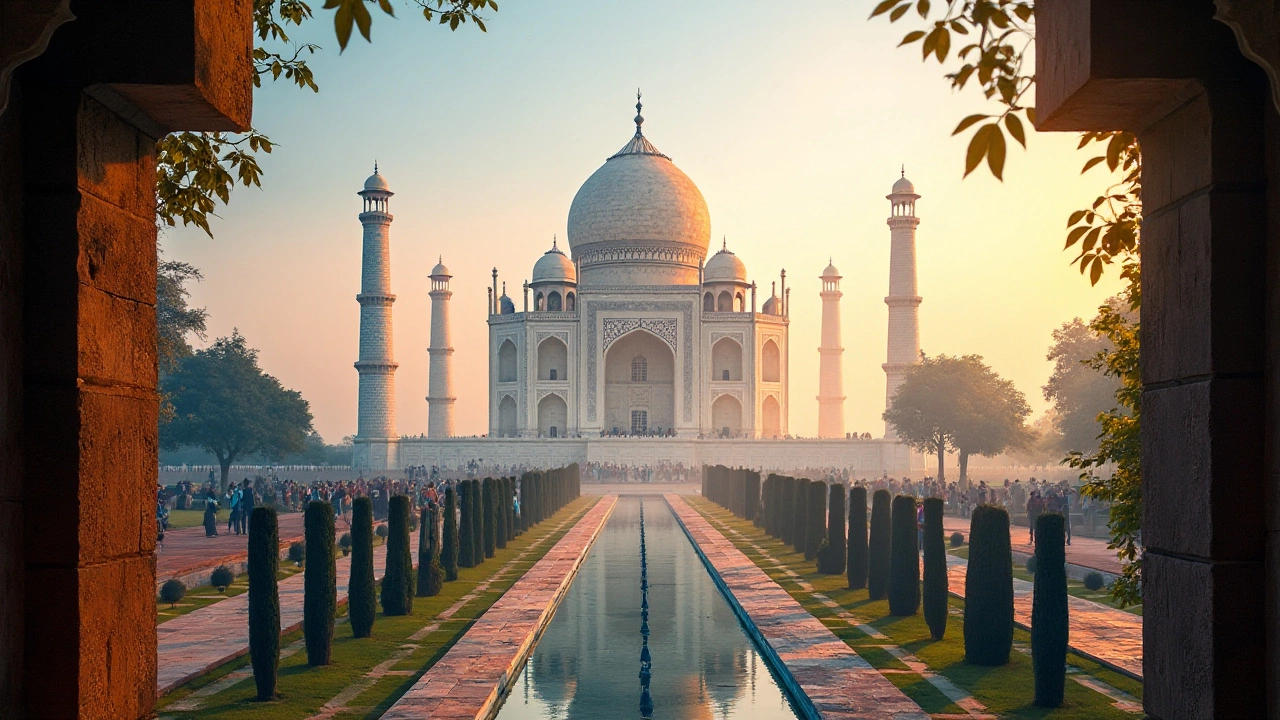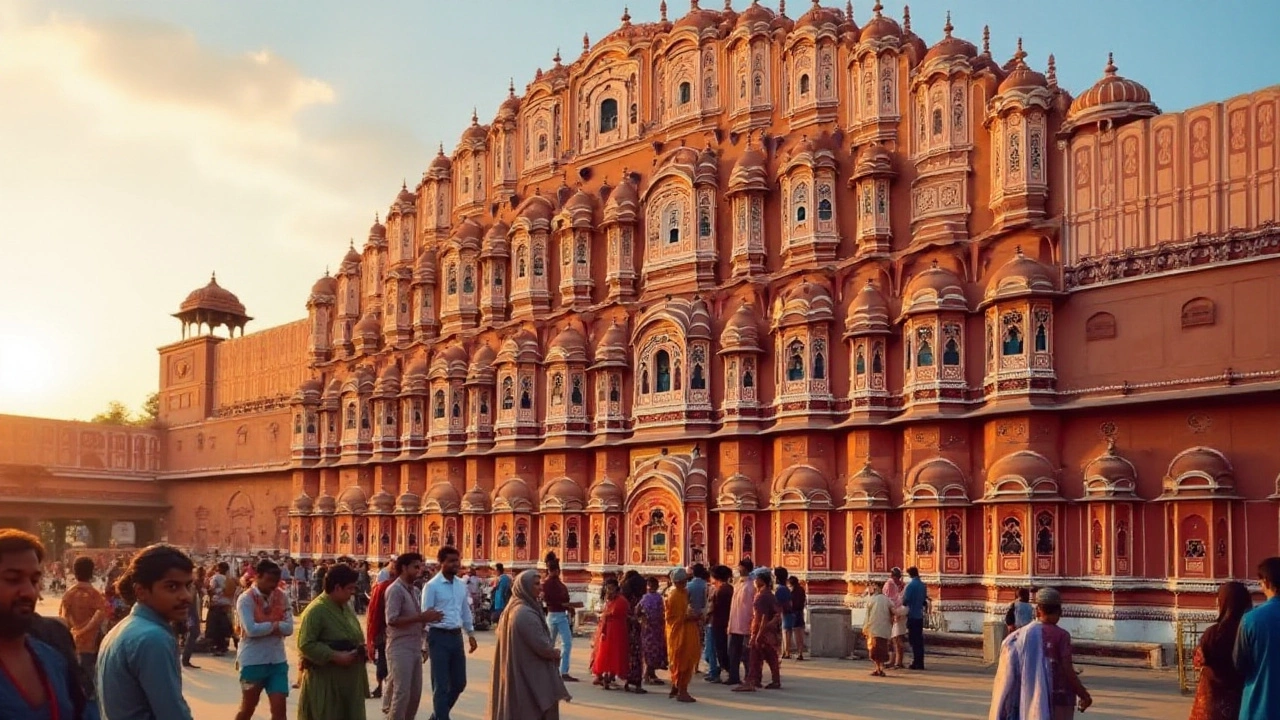Exploring India's Golden Triangle: A North Indian Tourism Guide
 Jan, 16 2025
Jan, 16 2025
Imagine embarking on a journey that reveals India's vibrant tapestry through its most iconic cities: Delhi, Agra, and Jaipur. This is the Golden Triangle, a celebrated tourist circuit in North India, promising an adventure steeped in history, culture, and jaw-dropping architecture.
It is not just the destinations but the stories woven through each alley, monument, and local bazaar that captivate travelers from around the world. Whether you're marveling at the grandeur of the Taj Mahal, walking through the majestic forts of Jaipur, or tasting delicacies in Delhi's bustling streets, the Golden Triangle offers a perfect introduction to the heart and soul of India.
- Introduction to the Golden Triangle
- Delhi: The Heart of India
- Agra: Beyond the Taj Mahal
- Jaipur: The Pink City's Charms
- Practical Travel Tips
- Crafting Your Golden Triangle Itinerary
Introduction to the Golden Triangle
When one thinks of North India tourism, the Golden Triangle often comes to mind as an essential pilgrimage for travel enthusiasts. This mythical triangle is formed by linking three of India's most historic and culturally rich cities: Delhi, Agra, and Jaipur. Situated in Northern India, the Golden Triangle has been named so because of the triangular shape formed by these locations on a map. Each point of the triangle hosts an incredible wealth of monumentality and heritage that has drawn millions of tourists each year.
Delhi serves as the starting point of this golden route, presenting a bustling metropolis that weaves together its ancient roots with modern marvels. Not far from there lies Agra, a city synonymous with love and immortality. Agra is revered worldwide for the majestic Taj Mahal, but its significance extends beyond this single monument, as the city is dotted with architectural gems that echo its Mughal past. Finally, Jaipur, the capital of Rajasthan, known as the Pink City, offers a warm embrace with its grand palaces and vibrant culture. The journey through the Golden Triangle is one that captures the very essence of India.
Exploring the Golden Triangle isn't just about landmarks. The region pulsates with life and color, a testament to India’s diverse cultural fabric. The streets are alive with energy—from local markets selling traditional crafts to colorful festivals that bring everyone together. Every corner, every turn tells a story, waiting to be discovered by those eager to delve beyond surface-level impressions. The Golden Triangle is not a mere trip; it is an enriching experience that stays with you long after.
"Traveling across the Golden Triangle is like peeling back layers of a vibrant tapestry," remarks renowned travel author, Mark Savage. "It's where you encounter the soul of India, in its bazaars, its people, and its epic history."
For anyone planning to embark on this journey, a few practical considerations can help make the trip enjoyable and smooth. The ideal route begins in Delhi and continues onward to Agra, then to Jaipur, forming a loop that brings you back to the capital. Travelers often take six to seven days to cover the circuit comfortably, ensuring ample time to explore key attractions deeply. Transport options are varied, with numerous trains, buses, and private taxis connecting these cities, which makes travel easy and flexible for visitors. The Golden Triangle is also famed for its comprehensive hospitality services, offering everything from luxury accommodations to delightful local eateries.
Whether you're a history buff, culture enthusiast, or simply seeking an adventure, the Golden Triangle promises an unforgettable journey. It's a circuit that not only showcases India's iconic monuments but also immerses you in its unique charm and hospitality. As you tread the paths that millions have walked before, you're bound to create your own stories and lasting memories that link you to this enchanted land.
Delhi: The Heart of India
Delhi, a city where ancient history seamlessly fuses with the cosmopolitan hum of innovation, is truly the heart of India. This vibrant capital offers a rich tapestry of experiences, drawing visitors into its bustling streets lined with relics of bygone eras. As you wander through Delhi, the contrast between majestic structures like the Qutub Minar, the towering Red Fort, and the impressive India Gate, alongside modern marvels such as the Lotus Temple and the resplendent Akshardham, narrates a tale of a city embracing its past while sprinting towards the future.
The capital city is also a paradise for explorers and food lovers alike. In Old Delhi's Chandni Chowk, diversity comes alive amidst the tantalizing aroma of spices and sweets. This bustling bazaar invites you with its maze of lanes filled with everything from colorful bangles to the sizzle of street food like chaat and paratha. As you taste these delectable offerings, you understand why Delhi is not just a city but an emotion that stays with everyone who walks its alleys. Staying true to its reputation, Delhi is not shy to showcase its prowess in politics as well. The corridors of power in New Delhi are home to important establishments, such as the Rashtrapati Bhavan and the Parliament House, embodying the governance and democratic spirit of India.
The cultural landscape is equally compelling. Delhi boasts world-class museums like the National Museum and the Museum of Modern Art, along with vibrant performance spaces such as the Kamani Auditorium and the India Habitat Centre. A stroll through the verdant Lodhi Gardens not only offers a peaceful retreat from the urban tumult but also a perspective on Delhi's multifaceted identity through the ancient tombs punctuating its lush expanse. There's a saying that echoes through the ages, capturing the essence of this city: "Delhi is not just a place to live, but a way of life."
A dynamic calendar of festivals ensures that at any given time, Delhi is in celebration. Whether it's the grand Republic Day Parade that paints Rajpath with patriotism and fervor, or the vibrant Diwali light displays that transform the city into a spectacle of colors, Delhi knows how to mark an occasion. Visitors can plan their trips around such local festivities, maximizing their exposure to the cultural vibrancy. Truly, the trip to Delhi begets a deeper understanding of North India tourism by immersing travelers in experiences quintessential to the region. The land of contrasts invites exploration, promising sights and sounds that evoke both wonder and introspection.

Agra: Beyond the Taj Mahal
The city of Agra, eternally linked to the magnificent Taj Mahal, is a treasure trove of remarkable experiences waiting to be uncovered. While the Taj stands as a testament to undying love and architectural brilliance, there is much more to explore in this impactful city. The Golden Triangle India offers a delightful dive into history with Agra at its heart, surrounded by echoes of the Mughal Empire's past and its wondrous legacies. Agra is home to the sprawling Agra Fort, a UNESCO World Heritage site constructed mainly of red sandstone that offers a glimpse into the prowess and opulence of the Mughal rulers. Walking through its corridors feels like traveling back in time as each nook narrates tales of power, deceit, and valiant battles.
Exploring beyond the obvious, the enchanting Itmad-ud-Daula, often called the 'Baby Taj', should not be missed. This tomb, an exquisite smaller monument, predates the Taj Mahal and is a beautiful display of intricate inlay work that later inspired the design of its more famous cousin. A visit here reveals Agra's role as a melting pot of art and skill, with its inmate white marble adorned with semi-precious stones—a precursor to the Taj Mahal's grandeur. Stopping by the bustling Kinari Bazaar, a vibrant market dating back centuries, allows visitors to connect with Agra’s heart and soul, teeming with colorful textiles and spices, all while the air is filled with tales of a bygone era.
"Agra itself is the best judge of how powerfully the Mughal dynasty impressed its cast." - William Dalrymple
In every corner lies a different tale, and the sprawling Mehtab Bagh offers a leisurely backdrop across the Yamuna River for an alternative view of the Taj Mahal, especially during the ethereal glow of sunset. This historic Mughal garden is designed to provide symmetry in harmony with the grandeur across its waters. To dive deeper into Agra's past, a detour to Fatehpur Sikri cannot be overlooked. Once the flourishing Mughal dynasty's capital, this city amidst the arid plain boasts magnificent red sandstone constructions encapsulating stories of Emperor Akbar's ambition and spirituality.
For those keen on culinary explorations, Agra tantalizes the taste buds with an array of Mughal-inspired dishes. Savoring petha, a delightful sweet made from white pumpkin or ash gourd, is a must while in the city. Traditional Mughal recipes still grace the local eateries, invoking the flavors cherished by the royals themselves. Agra provides an intricate tapestry of experiences beyond its crown jewel, blending heritage and culture seamlessly, waiting to be admired and cherished by travelers looking to explore the full spectrum of the North India tourism lineage.
Jaipur: The Pink City's Charms
Stepping into Jaipur, the Pink City, is like opening an opulent chapter from a bygone era. This city, with its powdered pink hues, isn't just about its famous color; it's a living canvas of artistry, history, and vibrant culture. The story of Jaipur's rosy tint dates back to 1876 when Maharaja Ram Singh painted the city pink to welcome the Prince of Wales. Today, it stands as a timeless symbol of Rajput hospitality.
Wandering through Jaipur, one cannot miss the grandeur of the Amber Fort. Nestled atop a hill, the fort is a splendid fusion of Rajput and Mughal architecture. It unfolds like a well-penned saga with its intricate mirror work in the Sheesh Mahal and the verdant vistas from its battlements. As you tread its corridors, imagine the tales of valor and opulence echoing through its historic walls.
In the heart of Jaipur lies the iconic Hawa Mahal, or 'Palace of Winds'. With its 953 honeycombed windows, it's not merely an architectural wonder but a testament to the city's artistic soul. The palace designed for royal women to observe street festivities without being seen, carries whispers of their everyday lives. “Jaipur is the most beautiful place on Earth—a dream made real,” once said noted historian William Dalrymple, capturing the enchantment that holds every visitor spellbound.
Beyond its palaces and forts, Jaipur's bazaars are bustling havens for vibrant textiles and exquisite handicrafts. Stroll through Johari Bazaar for shimmering jewels or Bapu Bazaar for traditional Rajasthani textiles. Each shop is a treasure chest, revealing handcrafted artistry that's evolved over centuries. These markets provide a peek into the artisanship that Jaipur nurtures with pride.
No visit to Jaipur is complete without savoring the local cuisine. The city's culinary landscape mirrors its royal heritage, with dishes like Dal Baati Churma and Laal Maas tantalizing the palate. Every bite tells a story, enriched by ages-old recipes and flavorful spices. Whether dining in a palatial setting or at a bustling street stall, Jaipur's culinary offerings are sure to leave an indelible mark on your taste buds.
For those seeking an overview of Jaipur's cultural and historical significance, here is a summary in numbers:
| Attraction | Visitors (Annually) |
|---|---|
| Amber Fort | 2.3 Million |
| Hawa Mahal | 1.5 Million |
| City Palace | 1.2 Million |
Delving into Jaipur's myriad attractions, you don't just witness history; you become part of its living heritage. Whether through its forts, flavors, or festivities, the Pink City lingers on the senses, making every journey an unforgettable chapter in one's life.

Practical Travel Tips
Embarking on the Golden Triangle India journey is as much about strategic planning as it is about reveling in the sights. Travelers often find themselves juggling itineraries, accommodations, and transport in this bustling circuit. To maximize your experience, start by determining the best time to visit. The period from October to March is usually delightful, offering the most pleasant weather for exploring the iconic cities of Delhi, Agra, and Jaipur.
Transportation is a significant part of this journey, given the triangle’s hefty travel distances. Opting for a comfortable, air-conditioned car with a reliable driver is the most convenient way to navigate the circuit. For those seeking adventure, India’s extensive railway network connects these cities efficiently, albeit with a unique flavor of its own. It’s worth noting that trains offer a novel experience, presenting slices of rural life whizzing past the windows. The Shatabdi Express and Gatimaan Express are two rapid train services connecting the core cities, ensuring a swift journey across your itinerary.
Accommodation within the Golden Triangle covers a wide spectrum, from luxurious heritage hotels to convenient budget stays. Delhi boasts prestigious hotels like the Oberoi and Taj, promising opulence amid the throbbing hustle-bustle. Agra, home to the Taj Mahal, offers budget-friendly choices near its landmarks, ensuring visitors maximize their sightseeing pleasures. Finally, Jaipur’s ‘pink city’ character reflects in its hospitality, with palatial hotels and intimate homestays making your stay memorable.
When planning your itinerary, flexibility is key. Each city is vibrant, replete with myriad facets waiting to be discovered. Allow ample time to slow down and soak in the local culture. Delhi's historic Red Fort and bustling Chandni Chowk markets require time and patience to explore. Agra’s Mughal delicacies will entice you beyond the confines of the Taj Mahal. In Jaipur, dive into captivating bazaars and forts like Amer and Nahargarh, savoring every minute of the day. A seasoned traveler once wisely said,
"Travel is not about the destination, but the journey."Embrace the local rhythm, cherish the moments, and seize every opportunity to learn something new.
Health and safety should never be an afterthought. Remember to carry a travel medical kit equipped with essentials for any unexpected situations. Bear in mind the safety tips when traversing crowded areas, such as keeping your belongings close and being aware of your surroundings. Keep copies of vital documents, both in hard copy and digital formats. These small actions ensure peace of mind, granting more freedom to indulge in the wonders of the North India tourism experience.
Crafting Your Golden Triangle Itinerary
Planning a journey through India’s Golden Triangle is both exciting and a tad overwhelming given the vast array of experiences on offer. The circuit is a harmonious blend of history, culture, and cuisine, something every traveler dreams of soaking in. Depending on your interests and the amount of time at your disposal, you can customize your itinerary to make the most of each city’s unique allure, ensuring that you don’t miss out on any of the iconic landmarks and hidden gems.
Choosing Your Starting Point
Typically, most ventures into the Golden Triangle begin in Delhi, thanks to its well-connected airport catering to international flights. But it’s equally feasible to start from Jaipur or Agra, depending on where you’re coming from or where you’d like to head afterward. Each city offers its distinct flavor and rhythm. For instance, Delhi, with its mix of old-world Mughal splendor and sprawling contemporary cityscape, could easily fill your days with sights ranging from the Red Fort to bustling Chandni Chowk. As one local aptly put it, "There is a comforting chaos here, where history meets the hum of today."
Allocating Time Wisely
A conventional itinerary could span anywhere from five to seven days. It's advisable to allocate at least two days to each city to fully appreciate their unique characteristics. Starting in Delhi, you can revel in its architectural grandeur and culinary diversity. Agra merits at least a day, not only for a sunrise view of the Taj Mahal but also for the quiet beauty of the Itimad-ud-Daulah's Tomb. Jaipur deserves attention for its forts, palaces, and colorful bazaars. Don’t forget to schedule moments of rest to absorb the rich legacy of the places you visit.
Planning Practical Logistics
Transport is key, and there are a variety of options to consider. The distances between Delhi, Agra, and Jaipur are quite manageable, with each leg of the journey taking roughly 4-6 hours by car or train. Hiring a driver can be the most convenient option, providing flexibility and the chance to stop at lesser-known spots en route, like the abandoned and enchanting Fatehpur Sikri or the bird sanctuary at Bharatpur. For budget-conscious travelers, trains remain a charming alternative, where you can experience India’s railways and mingle with locals.
Making the Most of Local Insights
Engage with locals, as their insights can lead you to lesser-known experiences. Whether it’s finding a quaint café tucked away in a quiet corner of Jaipur, being guided to a hidden spot with breathtaking views of the Yamuna River in Agra, or learning about the best times to visit landmarks in Delhi to avoid crowds, these nuggets of wisdom enhance your itinerary. One such traveler from New York shared, "I relied on locals more than on Google Maps, and the serendipitous experiences were unforgettable."